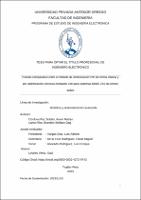Mostrar el registro sencillo del ítem
Estudio comparativo entre el método de sintonización PID de forma clásica y por optimización convexa mediante LMI para sistemas MIMO 2X2 de primer orden
| dc.contributor.advisor | Linares Vértiz, Saúl | |
| dc.contributor.author | Córdova Paz Soldán, Kevin Matías | |
| dc.contributor.author | Lama Ríos, Brandon Stefano Dag | |
| dc.creator | Córdova Paz Soldán, Kevin Matías | |
| dc.date.accessioned | 2024-01-19T13:58:01Z | |
| dc.date.available | 2024-01-19T13:58:01Z | |
| dc.date.issued | 2024 | |
| dc.identifier.uri | https://hdl.handle.net/20.500.12759/18771 | |
| dc.description.abstract | En el presente trabajo de investigación se puso como objetivo establecer qué tipo de control es mejor en base al menor tiempo de establecimiento que se presente de los dos controles que son: método convencional y el método de optimización convexa mediante LMI, para plantas MIMO 2x2 de primer orden. Cabe resaltar que en la actualidad no hay muchos trabajos que tengan como fundamento LMI para sintonización, es por eso que para poder obtener los tiempos de establecimiento se procedió a simular el entorno mediante el modelo matemático extraído de trabajos anteriormente desarrollados. Al tener todo el escenario listo, se procede a realizar la toma de datos en todos los casos con variaciones en los modelos matemáticos para poder determinar una generalidad. Se encontró que, de 40 datos obtenidos, en 38 hay una mejora, esto nos da un valor de 95% de mejora en base a la muestra total. Para poder validar la hipótesis, se utilizó la herramienta t-Student y así se puede determinar si hubo cambios o no, con esta herramienta se validó la hipótesis planteada. | es_PE |
| dc.description.abstract | In this research work, the objective was to establish which type of control is better based on the shortest establishment time that occurs between the two controls, which are: conventional method and the convex optimization method using LMI, for 2x2 MIMO plants of first order. It should be noted that currently there are not many works that are based on LMI for tuning, which is why in order to obtain the establishment times, the environment was simulated using the mathematical model extracted from previously developed works. Having the entire scenario ready, we proceed to collect data in all cases with variations in the mathematical models in order to determine a generality. It was found that, of 40 data obtained, there is an improvement in 38, this gives us a value of 95% improvement based on the total sample. In order to validate the hypothesis, the t-Student tool was used and thus it can be determined whether there were changes or not, with this tool the proposed hypothesis was validated | es_PE |
| dc.description.uri | Tesis | es_PE |
| dc.format | application/pdf | es_PE |
| dc.language.iso | spa | es_PE |
| dc.publisher | Universidad Privada Antenor Orrego | es_PE |
| dc.relation.ispartofseries | T_ING.ELECT_890 | |
| dc.rights | info:eu-repo/semantics/openAccess | es_PE |
| dc.rights.uri | https://creativecommons.org/licenses/by/4.0/ | es_PE |
| dc.subject | LMI | es_PE |
| dc.subject | Optimizacion | es_PE |
| dc.title | Estudio comparativo entre el método de sintonización PID de forma clásica y por optimización convexa mediante LMI para sistemas MIMO 2X2 de primer orden | es_PE |
| dc.type | info:eu-repo/semantics/bachelorThesis | es_PE |
| thesis.degree.grantor | Universidad Privada Antenor Orrego. Facultad de Ingenieria | es_PE |
| thesis.degree.name | Ingeniero Electronico | es_PE |
| thesis.degree.discipline | Ingenieria Electronica | es_PE |
| dc.subject.ocde | http://purl.org/pe-repo/ocde/ford#2.11.00 | es_PE |
| renati.advisor.orcid | https://orcid.org/0000-0002-4272-9743 | es_PE |
| renati.author.dni | 75709477 | |
| renati.author.dni | 72746395 | |
| renati.advisor.dni | 18092700 | |
| renati.type | http://purl.org/pe-repo/renati/type#tesis | es_PE |
| renati.level | http://purl.org/pe-repo/renati/level#tituloProfesional | es_PE |
| renati.discipline | 712026 | es_PE |
| renati.juror | Vargas Díaz, Luis Alberto | |
| renati.juror | De la Cruz Rodriguez, Oscar Miguel | |
| renati.juror | Alvarado Rodriguez, Luis Enrique | |
| dc.publisher.country | PE | es_PE |
Ficheros en el ítem
Este ítem aparece en la(s) siguiente(s) colección(es)
-
Ingeniería Electrónica [133]





